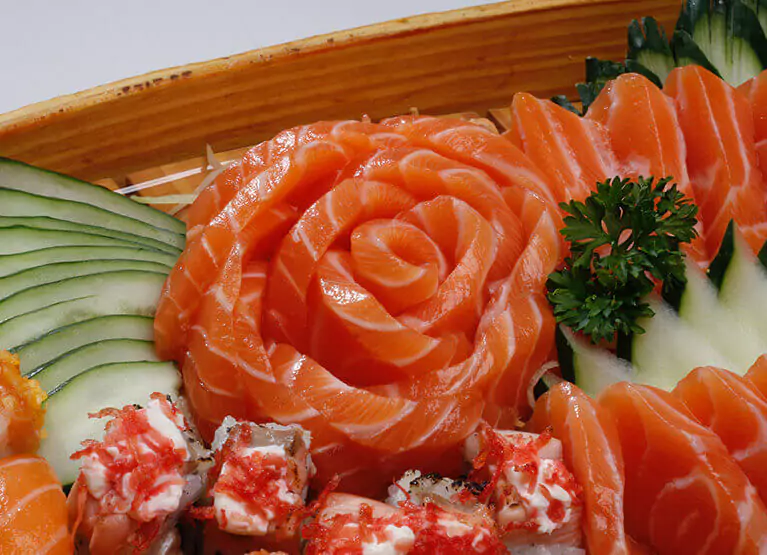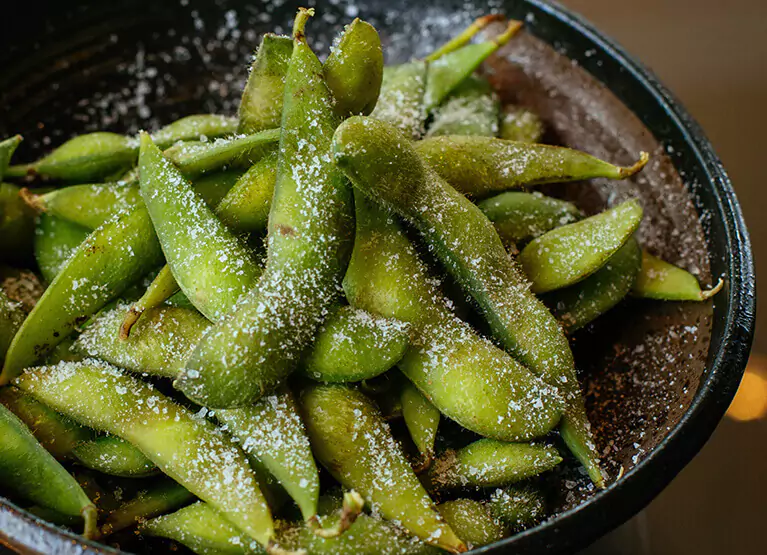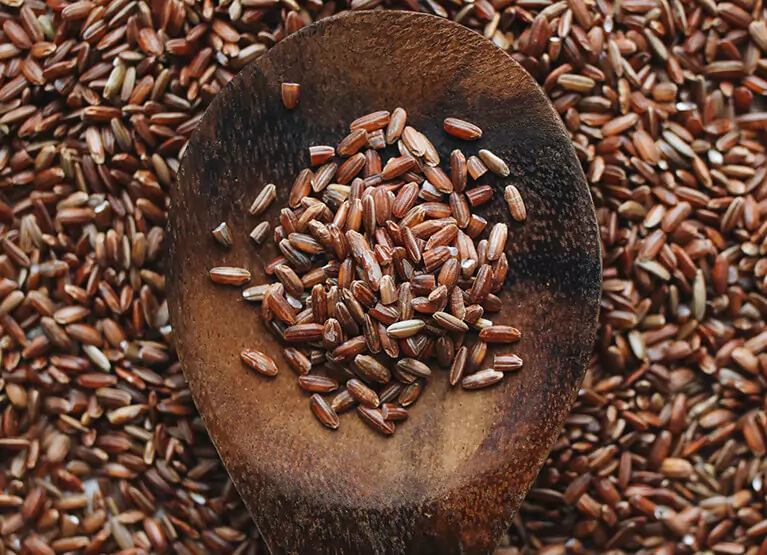Does Sushi Spike Blood Sugar?

Key Takeways
Sushi has been around for centuries and is one of Japan’s most famous traditional foods. You may be surprised to learn, however, that this delicious food has only risen in popularity over the last 60 years in America.
Despite its relatively recent entrance into American cuisine, sushi has evolved into a $27.5 billion industry in the United States. There are many different styles of sushi, but it often takes the form of a roll that contains some variation of rice, seaweed, vegetables and raw or cooked fish.
Sushi may seem like a glucose-friendly option due to its mix of protein, carbohydrates, and even fiber. But can these tasty rolls lead to a spike in blood sugar? Read on to find out.
What is Sushi?
The exact origins of sushi are unknown, but it most likely began in Japan in the 9th century. It was originally a way of making fish last longer—preserving fish in salt caused it to ferment and slowed the growth of bacteria.
Because sushi was originally a fermentation process, it took a long time to be prepared. It consisted of a piece of fish rolled into salted rice, and pressed under a weight to ferment for about six months.
Eventually, sushi makers began to use fresh fish that wasn’t preserved or fermented, giving birth to an early version of the sushi we eat today. This tasty food came to America in the 1960s, and you can now find sushi almost everywhere.
Types of Sushi

There are many types of sushi, ranging from raw fish to elaborate rolls filled with seaweed, rice, with multiple sauces. Here are some of the most popular types of sushi:
- Nigiri is made up of a hand-pressed mound of rice, usually served with a slice of raw fish on top.
- Maki is a sushi roll that consists of fish or other ingredients rolled in rice, with seaweed wrapped around the outside. The roll is served sliced into individual pieces.
- Uramaki is an “inside-out” version of maki. The ingredients are rolled in seaweed first, with rice on the outside. Like maki, it’s served in sliced pieces.
- Temaki, also known as a “hand roll,” is a hand-rolled sushi roll that is not cut up into pieces. It consists of ingredients wrapped in rice and a sheet of seaweed, served in a hand-held cone shape.
- Sashimi is a slice of raw fish, served with no rice. It is usually eaten with soy sauce and is a popular option at sushi restaurants even though it’s not technically classified as sushi.
Health Benefits of Sushi
There are a lot of reasons to love sushi, including its nutritional benefits. Here are just some of the health benefits of common ingredients found in sushi.
Fish

Fish is a common ingredient in all types of sushi. Fish is a lean source of protein, an essential nutrient that helps your body create and maintain healthy bones, muscles, cartilage, skin, and blood.
Unlike some protein sources, fish is low in saturated fat and high in omega 3 fatty acids, making it a healthy choice for your heart. In fact, regularly eating seafood is associated with a lower risk of cardiovascular disease.
Fatty fish especially, like tuna, sardines, mackerel, anchovies, salmon, and herring are good sources of omega 3 fatty acids, which can reduce your risk of heart attack and stroke. The FDA recommends eating about eight ounces of fish per week.
Seaweed
Sushi is often wrapped in nori, which are dried sheets of seaweed. Seaweed has a lot of nutritional value including dietary fiber, omega-3 fatty acids, essential amino acids, and vitamins A, B, C, and E.
Seaweed is able to absorb iodine from seawater, making it a great natural source of iodine. Iodine is an essential nutrient that is required for your thyroid to produce necessary hormones and also supports better cognitive function.
Seaweed is also rich in antioxidants that have antimicrobial and antiviral properties. These antioxidants can also have a positive effect on your cardiovascular health.
Ginger
Gari, or pickled ginger, is often served as a condiment alongside sushi as a palate cleanser. Ginger has been found to have many positive effects on human health.
Studies show that ginger may reduce inflammation in the body, reduce the risk of metabolic syndrome and colorectal cancer, improve digestive function, and help treat nausea. It may also reduce the risk of diabetes, and has a positive effect on blood sugar.
Rice Vinegar

Sushi rice is often made with rice vinegar. Vinegar is made from fermenting fruit, grains, or alcohol and has numerous health benefits.
Though the amount of vinegar in sushi rice is very small, studies show that vinegar may have a positive effect on your blood sugar after eating a meal. A study done on mice suggested that vinegar may also reduce cholesterol levels, help control weight, and have anti-inflammatory properties.
Wasabi
Wasabi or horseradish are often served as a condiment with sushi. Both wasabi and horseradish come from a plant in the mustard family.
Because of the high price of wasabi, much of the wasabi served in sushi restaurants is actually made from horseradish. Both have a similar spicy, pungent flavor.
A 2020 study found that wasabi increased the amount and diversity of the healthy bacteria in the gut microbiome of mice, which had positive effects on their weight and cholesterol. While this study is promising, additional research is needed to confirm these findings have the same effects on humans.
Other Common Ingredients
Avocados, cucumbers, and carrots are common ingredients found in uramaki rolls. Avocados are high in fiber, which can support digestive health and optimal blood sugar levels.
Avocados are rich in essential vitamins and minerals such as vitamin B, vitamin C, and potassium. They’re also a good source of monounsaturated fat and fiber, which can help reduce LDL cholesterol levels and lower your risk of heart disease and stroke.
Cucumbers, another common vegetable in sushi rolls, may have a positive effect on diabetes and cholesterol. Cucumbers also contain antioxidants that may protect your cells from free radical damage.
Carrots are a great source of vitamin A, which also has antioxidant effects and a positive effect on your vision and immune system. They are also high in fiber and linked to a reduced risk of high blood pressure and cardiovascular disease.
Does Sushi Spike Blood Sugar?

While some of the common ingredients of sushi have a wide range of health benefits, sushi itself may lead to blood sugar spikes for some people because of its high carbohydrate content. Here are some of the ways sushi can affect blood sugar.
Refined Carbs
Sushi usually contains white rice, which is considered a refined grain. A refined grain is a grain that has had the bran and germ removed, which reduces its fiber content. Common refined grains include white bread, white rice, and products made with white flour.
A diet high in refined grains can lead to low-grade inflammation in your body, and can cause spikes in blood sugar. Consistently high blood sugar levels may increase your chance of developing insulin resistance and obesity.
Research indicates that individuals who eat a diet high in refined carbs are more likely to develop type 2 diabetes. Complex carbs such as whole grains, on the other hand, have been linked to better glycemic control.
It's also important to note that resistant starch may be produced when cooked rice is cooled, and sushi rice may contain some resistant starch. However, each individual's glucose response to sushi may vary, so test this out for yourself to see your response.
High Glycemic Index
Because the amount of rice and other ingredients in sushi varies by type, it’s hard to say what the exact glycemic index (GI) of sushi is. Sushi rice on its own has a GI of about 89, which is considered high.
However, since the glycemic index of a food doesn’t take into account how much of it you're likely to eat, the glycemic load measurement, or GL, was developed. Glycemic load takes the amount of carbohydrates in a food into account.
A typical roll of sushi with rice has a glycemic load of about 11, which is considered moderate. This means it may have an effect on your blood sugar, though this effect may vary depending on the individual.It’s important to remember that the GI and GL system should be seen as just one tool for predicting your glucose response from foods. If you are unsure about how much sushi is safe for you to eat, talk to your doctor or nutritionist.
Added Sugar

Sushi rice is often made with sugar to cover the sour taste of the vinegar. It’s hard to know exactly how much added sugar is in sushi, however, because the type and preparation can vary.
The California roll and the Philadelphia roll, for example, are two popular types of uramaki in the United States. These rolls contain around seven to eight grams of sugar per 200 gram serving, or about eight pieces. However, other types of rolls that contain little or no sushi rice may have less added sugar.
Added sugars can increase your chance of both prediabetes and type 2 diabetes, as well as inflammation and obesity. If you are concerned about the effect of added sugars on your blood glucose levels, you may want to limit sushi rolls that contain rice.
Glucose-Friendly Tips for Enjoying Sushi
If you want to enjoy sushi but you are conscious of your glucose response, here are some tips to help you limit sharp blood sugar spikes.
Opt for Sashimi or Nigiri
Sashimi and nigiri have less rice than a typical sushi roll. Sashimi has no rice, and is generally served only with soy sauce.
A 200 gram serving of salmon nigiri, or about four pieces, has just about one gram of sugar. Nigiri contains less rice and significantly less sugar than a typical maki or uramaki roll.
Start Your Meal With Edamame or Wakame

Studies show that eating protein or fiber before carbohydrates may reduce blood sugar spikes and increase satiety after a meal. This is commonly referred to as meal sequencing.
Edamame are young soybean pods commonly served in sushi restaurants as an appetizer. A half cup serving contains about nine grams of protein and four grams of fiber.
Wakame, a seaweed salad that is also widely available in sushi restaurants, contains about three grams of protein. Starting your meal with a side of wakame or edamame before eating your sushi may help you reduce your chance of a large spike in blood sugar.
Limit High-Sugar Sauces and Tempura
Sushi is often served with sauces that are high in sugar. For example, eel sauce (a sweetened soy sauce commonly served alongside sushi) contains about six grams of sugar per tablespoon.
Tempura is a tasty dish made of battered and fried seafood, sushi rolls, or vegetables. However, because they are dipped in flour, a starch, tempura may lead to a spike in blood sugar.
Opt for Whole Grains If Possible

Sushi is occasionally served with brown rice or quinoa in place of the typical white sushi rice. Brown rice and quinoa are whole grains, which may improve your blood sugar response after a meal.
Find the right Nutrisense programto turn insight into progress.
Go Beyond Glucose Data with Nutrisense
Your glucose can significantly impact how your body feels and functions. That’s why stable levels are an important factor in supporting overall wellbeing. But viewing glucose isn't enough. Nutrisense, you’ll be able to learn how to use your body's data to make informed lifestyle choices that support healthy living.
One-to-one coaching
Sign up to access insurance-covered video calls to work with a glucose expert: a personal registered dietitian or certified nutritionist who will help tailor your lifestyle and diet to your goals.
Monitor and measure what matters
With the Nutrisense CGM Program, you can monitor your glucose with health tech like glucose biosensors and continuous glucose monitor (CGM)s, and analyze the trends over time with the Nutrisense App. This will help you make the most informed choices about the foods you consume and their impact on your health.
Find your best fit
Ready to take the first step? Start with our quiz to find the right Nutrisense program to help you take control.

Heather is a Registered and Licensed Dietitian Nutritionist (RDN, LDN), subject matter expert, and technical writer, with a master's degree in nutrition science from Bastyr University. She has a specialty in neuroendocrinology and has been working in the field of nutrition—including nutrition research, education, medical writing, and clinical integrative and functional nutrition—for over 15 years.




